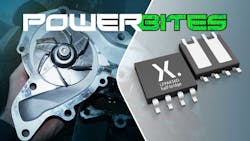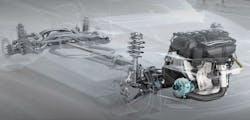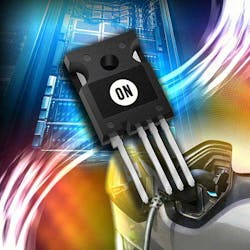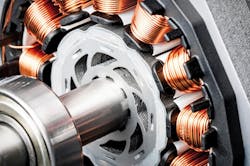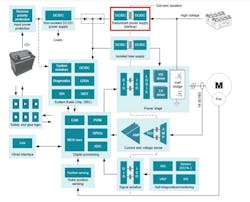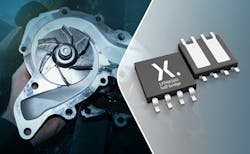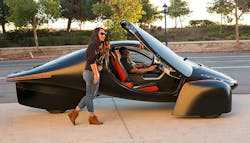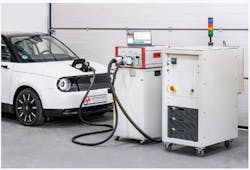This Week in PowerBites: The Automotive Edition
Smart Automotive LED Drivers Add Intelligence Everywhere but the Driver's Seat
Although ROHM's family of four-channel linear LED driver ICs escaped my attention when it was announced last year, their features and simplified thermal design were too interesting to ignore. Much of this two-minute video is basic stuff we learned in ET-102:
If you have the patience to get through it, there’s a solid description of their "smart" approach and how it simplifies designs while saving space, power, and, according to ROHM, solution cost. If this caught your attention, you can visit the product page on ROHM's website by clicking here.
Born to be Mild: Compact 48-V BLDC Motor Driver Helps Save Space in Mild-HEV Systems
The DRV3255-Q1, an AEC-Q100 Grade 0 brushless DC (BLDC) motor driver recently introduced by Texas Instruments, should help accelerate the development of mild hybrid electric vehicles (MHEVs), which use 48-V motor-drive systems. The three-phase, 48-V high-power driver module can deliver up to 30 kW for motor-control systems in MHEVs, such as traction inverters and starter generators while reducing overall motor system size by as much as 30%. The functional-safety-compliant motor driver was designed according to TI’s TÜV SÜD-certified functional-safety development process, enabling designs that can be certified for levels up to ASIL D.
MHEVs are being developed by many automobile manufacturers to rapidly reduce the greenhouse gas emissions of their existing internal-combustion-powered vehicle designs. In these applications, the DRV3255-Q's high drive current capability improves 48-V motor-drive system response times, enabling even heavy vehicles like SUVs and trucks to accelerate more quickly.
For motors requiring currents as high as 600 A, the DRV3255-Q1 can directly drive up to 1,000-nC gate-charge MOSFETs. In addition, the motor driver protects 48-V powertrain systems against switching transients as high as 95 V and load-dump conditions across a wide temperature range (−40 to 150°C). It also integrates both high- and low-side active short-circuit logic, which provides dynamic fault response by automatically switching the motor driver to active short-circuit mode in overvoltage conditions. This dual-mode approach protects the vehicle’s motor and electrical components from overvoltage stress while optimizing system performance.
To streamline the safety compliance certification process for end-use products, the DRV3255-Q1 was designed using TI’s certified functional-safety hardware-development process. It includes built-in safety mechanisms and documentation such as failure modes, effects and diagnostic analysis, and a functional safety manual. In addition to the safety mechanisms for the device’s internal failure modes, the digital input/output pins withstand up to 75-V absolute maximum ratings to protect the DRV3255-Q1 against an external 12-V power-supply overvoltage.
The DRV3255-Q1 is now available from TI in a 64-pin quad flat package. Pricing starts at US$3.99 in 1,000-unit quantities. For more information, see www.ti.com/DRV3255-q1-pr. For additional information on developing applications with the DRV3255-Q1, download the white paper “How to Build a Small, Functionally Safe 48-V, 30-kW MHEV Motor-Drive System.”
650-V SiC MOSFETs Deliver Superior Switching, Density, Automotive-Grade Reliability
ON Semiconductor announced a new series of AECQ101 and industrial-grade-qualified, 650-V-rated silicon-carbide (SiC) MOSFETs for demanding applications in which power density, efficiency and reliability are key considerations. Their switching speed, efficiency, and thermal characteristics translate into enhanced power density, reduced electromagnetic interference (EMI), and reduced system size and weight at the system level.
With these new SiC devices, according to the company, designers can create products such as EV on-board chargers (OBCs), solar inverters, server power-supply units (PSUs), telecoms, and uninterruptible power supplies (UPS) with significantly better performance and reliability than comparable silicon-based designs. The MOSFETs employ ON Semi's novel active cell design combined with advanced thin wafer technology that give the device a best-in-class figure of merit Rsp (RDS(on)* area) for 650-V breakdown voltage. The NVBG015N065SC1, NTBG015N065SC1, NVH4L015N065SC1, and NTH4L015N065SC1 have the lowest RDS(on) (12 mΩ) in the market. This technology is also optimized to minimize energy loss, enabling best-in-class performance in automotive and industrial applications.
The devices feature an internal gate resistor (Rg) that’s been optimized for best switching speed while minimizing EMI, eliminating the need to apply an external gate resistor. The MOSFET's higher surge capacity, avalanche capability, and short-circuit robustness contribute to enhanced ruggedness that delivers higher reliability and longer device lifetimes. The new devices are all surface-mount and available in industry-standard package types including TO247 and D2PAK. For additional information about ON's 650-V SiC MOSFETS, click here.
Precision Magnetic Rotary Position Sensor Boosts Electric-Motor Efficiency, Reliability
A new magnetic rotary position sensor developed by ams is intended to help designers create safer, smarter, and more efficient electric vehicles. The AS5116 is a AEC-Q100 Grade 0 qualified device that provides accurate, contactless angle measurements in demanding automotive applications such as high-speed motors. The sensor's outputs feature inherent nonlinearity of just 1 degree (maximum) over a full 360-degree turn at rotation speeds up to 30,000 rpm. Output noise is a low 2.47 mV (rms) at an operating voltage of 5 V. These characteristics enable the AS5116 to produce accurate measurement outputs, providing the foundation of efficient motor commutation.
The AS5116 was designed for reliable operation, with differential sensing architecture outputs that reject interference from stray magnetic fields that are commonly induced by a vehicle’s high-voltage cabling and other components. When properly housed within a motor, the contactless magnetic sensor is isolated from degradation caused by dust, dirt, grease, moisture, and other contaminants. These features enable manufacturers to eliminate the expensive and cumbersome shielding required by competing sensor systems while maintaining safe operation.
The AS5116 comes in an AEC-Q100 Grade 0 qualified 8-pin SOIC package with a footprint of 4.9 × 6.0 mm, making it easy to integrate into automotive-system board layouts. It’s supplied with a dedicated safety manual to support customers’ ISO 26262 compliance efforts.
The AS5116 rotary position sensor IC is available now in production volumes. For sample requests or more technical information, go to https://ams.com/AS5116.
Battery-to-Battery Backup for EVs
EVs are currently in a transitional state, with most cabin electronics still reliant on legacy 12-V power systems and, in most cases, a failure-prone lead-acid 12-V battery. In a recent application report, Texas Instruments looks at how to improve an EV's reliability by including a fully isolated, high-voltage to low-voltage backup supply in the traction inverter system to power the low-voltage components upon failure of the 12-V battery.
Click here to read "Increase Traction Inverter System Robustness with a HV to LV Backup Supply" (PDF).
Compact AEC-Q101-Rated MOSFET Half-Bridge Reduces Inductive Parasitics
Nexperia's new series of half-bridge (high side and low side) automotive power modules are constructed in the space-saving AEC-Q101-qualified LFPAK56D package format. The compact module integrates the MOSFETs, thermal control components, and connector hardware needed for a complete half-bridge solution to deliver up to 98 A, suiting it for three-phase automotive powertrain applications such as fuel and water pumps, motor control, and dc-dc power conversion.
The resulting solution occupies 30% less PCB area and produces 60% less parasitic inductance than a comparable design based on discrete MOSFETs. The package format also features flexible leads to improve overall reliability, and an internal copper-clip connection between the MOSFETs that simplifies PCB designs and enables plug-and-play integration with next-level systems.
Typically, in a half-bridge arrangement, the PCB connection between the source of the high side MOSFET and the drain of the low side MOSFET can create a significant amount of parasitic inductance. However, with its internal clip connection, the LFPAK56D half-bridge package achieves 60% less inductance.
The new LFPAK56D half-bridge MOSFETs launched are the BUK7V4R2-40H and the BUK9V13-40H. Both utilize the highly robust Trench 9 automotive silicon process technology, are rated at 40 V, and are verified at twice the automotive AEC-Q101 specification in key tests. RDS(on) of the devices measures 4.2 mΩ (BUK7V4R2) and 13 mΩ (BUK9V13).
For more information, including product datasheets and quick learning videos, visit www.nexperia.com/lfpak56d-half-bridge.
Electric Underdogs: Will Your Favorite Upstart EV Maker End Up as Leader of the Pack or Roadkill?
2020 seems to have marked the break-over point where the automotive industry finally ran out of excuses for why they couldn't build electric cars and started to electrify their fleets. Much of the credit goes to a handful of upstart companies like Tesla and Rivian, which started the electric stampede by making what seemed impossible a few years ago look inevitable today.
Their unexpected successes scared many big car makers into rethinking what's possible and inspired many of us consumers to rethink what we dream of owning. So, it was a happy surprise when Aptera, one of editor Lee Goldberg's favorite upstart EV makers, returned from the dead and, once again, appears to have at least a shot at making it to production.
But, he wonders, how can you tell if the spunky little startup you're rooting for will end up as the leader of the pack or roadkill? Join Lee as he ponders this and other highly charged questions in his latest blog "Electric Underdogs."
Advanced Test Solution for EV Charging and Grid-Edge Applications
Keysight Technologies has launched the SL1200A Series Scienlab Regenerative 3-Phase AC Emulator, a comprehensive one-vendor solution that provides hardware, software, consulting, and support services for testing electric-vehicle (EV) and electric-vehicle supply equipment (EVSE) charging applications and grid-edge applications.
Keysight’s SL1200A series handles three-phase ac test needs up to 1,200 V ac, from 30 to 630 kVA, without the need for a transformer. Two voltage ranges are available: The 600 V ac is ideal for low-voltage inverter test as well as EV and EVSE charging test applications, while the 1,200 V ac allows for high-voltage ride-through (HVRT) testing without the need for a large, complex test setup.
The system addresses many of the issues arising from the rapid electrification of vehicles, which is expected to create significant charging demands on the grid, as well as the opportunities presented by vehicle-to-grid (V2G) power applications. Global power grids are approaching a time of rapid evolution and increased complexity, primarily driven by the growing adoption of variable renewable energy (VRE) and distributed energy resources (DERs) in the form of solar and wind. This and utility-scale battery storage is creating test challenges within EV/EVSE charging and grid-edge applications.
Keysight’s SL1200A series addresses these challenges with the following features:
- A high-power, three-phase ac and dc power source that integrates with EV/EVSE charging and inverter test solutions for complete test of devices.
- A dc output (Option SDC) enables high-power dc charging test, up to 1,000 V dc and 120 kW, eliminating the need and expense for extra equipment.
- 100% regenerative (bidirectional) power solution with >85% efficiency that reduces test costs.
- Achieve 1200-V line-to-line (L-L) at full specifications without extra equipment to reduce cost, increase performance, and save space.
Additional information about Keysight’s SL1200A series is available by clicking here.
